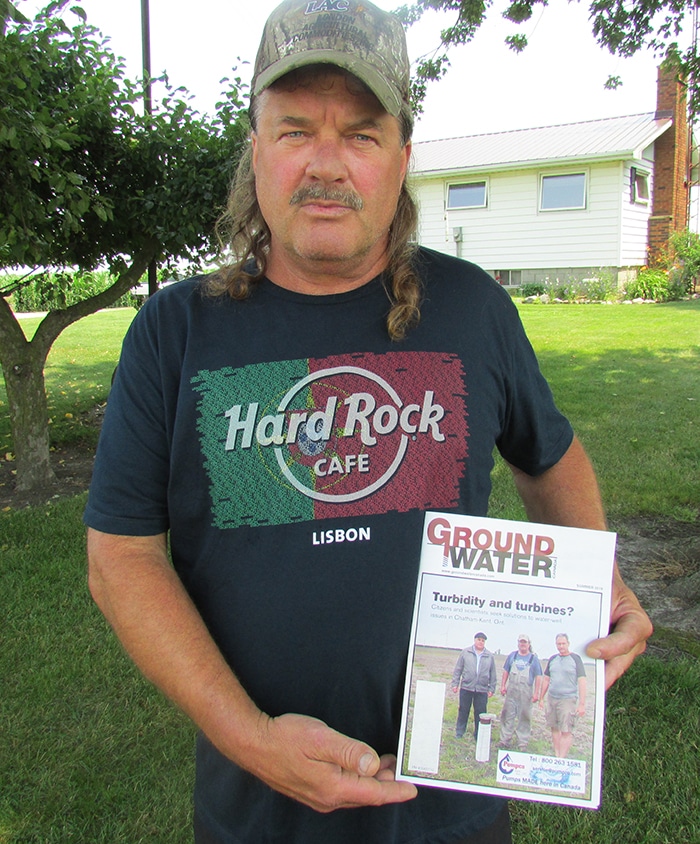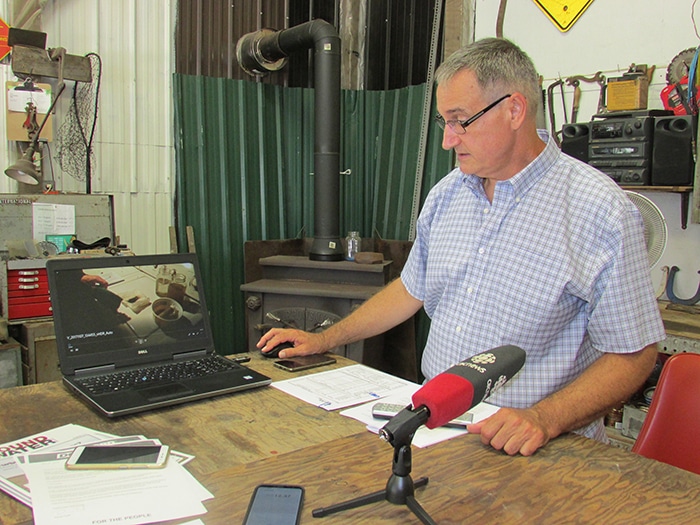
Dave Lusk holds a copy of Ground Water magazine showing a front-page article done on his well issues. Hair samples done by a Toronto lab show high levels of toxic metals in Lusk.
Co-founder of Water Wells First Kevin Jakubec said while he is cautiously optimistic about the news of a health hazard investigation into well contamination in Chatham-Kent, he has concerns with what he sees as “serious shortcomings” regarding how the government is handling the investigation.
MPP and Ontario Labour Minister Monte McNaughton announced July 19 the health hazard investigation into Chatham-Kent water wells contaminated with black sediment, acting on a promise made a year ago by a campaigning Doug Ford
The five-member panel doing the investigation is tasked with determining if the well water and the sediment it contains are safe for human consumption. Members include local geologist Dr. Keith Benn, environmental health scientist Dr. Glenn Ferguson, epidemiologist Dr. Shelley A. Harris who specializes in exposure measurement, toxicologist Dr. Ron Brecher and toxicologist Mark Chappel.
Jakubec said the toxicologists and epidemiologist are good news but at a press conference July 25, asked where were the expert geoscientist with experience in black shale formations, a hydrogeologist and a seismologist who would be able to provide the other pieces of the why and how questions on black shale clogging wells and filters. Kettle Point Black Shale that forms the bedrock in this area is known to contain heavy metals such as lead, uranium and arsenic.
Benn, who is on the panel as the lone geologist, is a structural geologist with expertise in the Canadian Shield and gold mining applications, according to his resume.
Jakubec also has concerns that AECOM, the company retained by the wind farms company, North Kent Wind, to collect samples of well water after complaints were made, refused to collect sediment samples, going as far as to filter out the black sediment from collected water samples at the home of Dave Lusk in Chatham township. If those reports and collections of well water samples from well complaints, including Lusk’s are being used as the basis of the health hazard investigation, Jakubec said there is bias going into the investigation.
Jakubec has video of an AECOM technician filtering out the sediment and taking pictures of it, but in the AECOM technical report to the MOE, the sediment was “mischaracterized” as a well equipment malfunction.

“Why aren’t they testing the sediment and why did the Ministry of the Environment not come and investigate? They have never been to Dave’s farm. This is discharge and that’s under section 15 of the Environmental Protection Act,” Jakubec said as he showed the video to media. “Any discharge never seen before is a violation of that section, especially if it impacts quality of life. He had no water at all.”
Lusk’s well casing blowing off water and gas, which the video shows, was also not reported as such in the report. Jakubec said the water was bubbling around the well cap during this time and shows gas was coming up through the ground at the same time, which requires several thousand pounds of pressure to do.
The AECOM report said the well’s spin-down trap malfunction was causing the water to blow out the well cap, which Jakubec said, is again, a mischaracterization.
Dr. Joel Gagnon, a professor at the University of Windsor and head of the heavy metals lab, was also at the press conference and explained his concerns with his research into the well contamination. He said he was asked by the Ministry of Health this past November to put his findings and concerns with the well contamination in a report for the Minister of Health, Christine Elliott, but he has heard nothing back from them since that time.
“Is there a health risk with consuming water from this well? It’s not as simple as collecting a water sample, measuring it for dissolved metals and comparing it to a table, because there is a combination of potential factors here, and potential exposures that make this situation unique to the point where looking at the incidence of disease in the human population may be the best to understand this. That’s how it’s done.”
To that concern, Lusk and Jakubec both took samples of their hair to a Toronto lab accredited to perform hair mineral analysis, and the results were disturbing. In Lusk’s report regarding toxic materials, he had high levels, above acceptable limits, of lead, cadmium and barium.
The test, Jakubec said, is based on the three previous months of exposure, which in Lusk’s case was dermal. Lusk said he hasn’t consumed water from his well since December of 2018 but he has been doing laundry and bathing in the water. He has a complex multi-filter filtration system on his well currently which filters out particles down to 0.2 microns, as does Jakubec.
Jakubec’s analysis report indicates he has a high level of barium in his system and he also does not drink his water, under recommendation from his doctor.
Both reports are dated July 10, and Jakubec said the results are a huge concern and should concern anyone with wells in the area, even if the particles can’t be seen with the naked eye.
Gagnon said this area, from just west of Chatham to about halfway to London is underlain by bedrock – Kettle Point black shale.
“It is different in that it contains considerable amounts of organic carbon and metals which can be considered toxic, depending on exposures and concentrations, and natural gas in the form of methane. It has been prospected in the past for shale gas and has been assessed as a potential environmental risk because of the metals in it,” Gagnon said. “It’s not a competent or tough rock; it’s quite fragile so it can be easily broken.”
At Lusk’s farm, he said there is about 45 feet of clay, then the contact aquifer is about two metres, which produces good water, and under that is the black shale bedrock. When the wind turbine pilings are driven through the bedrock, “it produces damage to the shale because (the pilings) are pounded in, not driven in, and there was evidence immediately upon construction of wind turbines, particularly in this location, that it was having an effect on well quality.”
Gagnon added that is when Lusk began to see his well cap spewing water and gas, and immediately after that, large volumes of black sediment.
Now that the turbines are operating, he said it is known that they vibrate. The vibration dissipates by travelling down the pilings and into the bedrock where they are anchored.
“That’s a design necessity, otherwise the turbines would self-destruct. That vibration is transferred to the bedrock and those vibrations can transmit through the bedrock, just like any other seismic wave,” Gagnon added.
The company hired by the wind farm companies, in the Golder report, said models show the vibration could not possibly be transmitted kilometres away from the turbine sites, and surface vibration testing also proved that theory.
Gagnon, however, said the vibrations in the bedrock could not be picked up by surface monitoring done by Golder Associates, and that the vibrations in the bedrock would cause the sediment created to vibrate.
“If a model says it can’t happen, but evidence says it can, then the model is wrong,” Gagnon stated.
Jakubec has asked McNaughton to hold a public meeting to discuss all the issues of concern with the investigation, including the part of the promise made by Ford to not only investigate, but to find out who is responsible for the well contamination and hold them responsible. He also wants to know what happened to the report expected from Ontario Chief Medical Officer of Health, who was tasked previously with reviewing the findings and reports from AECOM and the MOE.
He said the MOE was repeatedly asked to test the black shale sediment and the findings from area hydrogeologist Bill Clarke on pre-testing and post-testing of the water samples, including the sediment and its composition, were ignored.
He added a comprehensive population health study, testing the people on the wells and the incidence of illness is a necessity to get to heart of the question: is the water safe, not only to drink, but to bathe and do laundry in and feed livestock?






